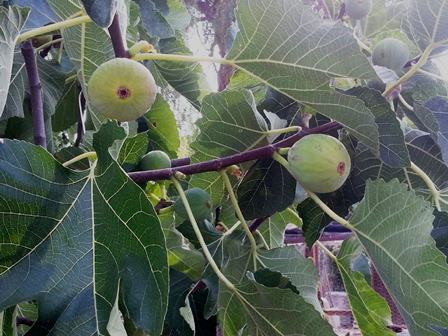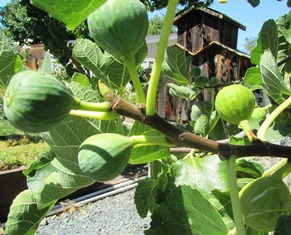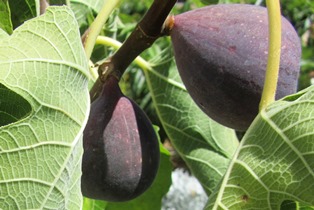What’s Not to Love about Edible Figs?
Many backyard gardeners start checking their fig trees this time of year for ripe fruit. Most figs grown for their fruit bear two crops a year (spring and fall). When figs are ripe, the globular fruit becomes soft and hangs downward from the branch. This fruit will not ripen on the windowsill or in a paper bag, so picking fruit while it is still firm is not advised.
I grow White Genoa, Adriatic, and Brown Turkey figs on my farmette. One of my nearest neighbors grows the Mission fig, which is a very large tree taking up most of his backyard. This time of year, his tree is heavily laden with purple-black fruit. Throughout the fall, that Mission fig tree is frequently visited by the birds, squirrels, and raccoons that eat the fruit.
Cooks appreciate the versatility of figs for cooking. There are many ways to prepare them. Grilled figs are delicious when served on a crostini with a dollop of goat cheese and drizzled with honey. The pulp can be used to make fig bars and other types of cookies. Luscious, juicy figs may be made into chutney or jam, baked in cakes, paired with almonds in a tart, sliced into salads, grilled with lamb, or served simply with port.
Fig trees are easy to grow, too. They need full sun and good drainage; many cultivars are drought tolerant. Lightly prune as necessary in winter. Enjoy.
* * *
If you enjoy reading about farmette topics (including gardening, beekeeping, and delicious recipes), check out my cozy mysteries A BEELINE TO MURDER and also THE MURDER OF A QUEEN BEE in the Henny Penny Farmette series (from Kensington Publishing).
These novels are available through online retailers such as Amazon, Barnes & Noble, Kobo Books, and Walmart as well as from traditional bookstores everywhere.
See, http://tinyurl.com/hxy3s8q
Now available in mass market paperback, this debut novel launched the Henny Penny Farmette series of mysteries and sold out its first press run.
See, http://tinyurl.com/h4kou4g
The second cozy mystery in the Henny Penny Farmette series, available Sept. 27, 2016, is now available on Net Galley (netgalley.com) for professionals and readers who write reviews.
Growing and Sharing Farmette Figs
It’s that time of year when our fig trees reward us with a second crop of sweet, juicy fruit, best eaten right from the tree.
We aren’t the only ones who love to eat figs. The birds and raccoons are leaving telltale marks that they’re helping us devour this sweet fruit. And it’s no wonder.
Figs are a nutrient-rich food with antioxidant properties. They contain magnesium, vitamin B6, fiber, and beneficial amounts of calcium and iron.
We grow a couple of varieties of figs on the farmette–a White Genoa and Brown Turkey. Our neighbors also have towering fig tree with a canopy that reaches over the neighbor’s house. The tree is loaded now with baseball-size, dark purple fruit. I believe it’s a Black Mission fig, introduced into California by Father Junipero Serra who planted them in 1769 at the San Diego mission.
Our Brown Turkey fig produces a crop twice each year. The first crop, known as the breba grows on last season’s wood. The second, and more abundant crop, grows on new wood.The fig has rose-colored flesh inside a brownish-purple skin that tends to crack open with the fig is overripe.
The White Genoa is self-fruitful and has yellow-green skin with strawberry-colored pulp. The taste is mild and sweet and can be enjoyed as fresh fruit or paired with tangy goat cheese. The tree bears two crops each year and benefits from a vigorous pruning in the autumn after the figs are harvested.
Both figs will lose their leaves, leaving only their bark color and scaffolding as winter interest in the garden. The White Genoa’s bark is light gray whereas the Brown Turkey has a darker shade of grayish-brown bark.
These trees can be grown in containers and kept to about six feet tall for people who don’t have a lot of space for a tree that can otherwise reach 15 to 20 feet.
Figs aren’t fussy about soil, but won’t tolerate excessive water. They like the sun and are pretty hardy here in Northern California. Many figs are self-fruitful, but keeping bees means I have pollinators to help the fig crops along.
The Figs Are Ripe, Fire Up the Grill
Last night the raccoons raided my fig trees, leaving a little deposit between honeybee apiary and the hen house. I know because this morning, I almost stepped in it . . . and I was barefoot and in still in my pajamas.
It was expecting the raccoons to drop by. It’s that time of the year when they like to show up for a little late night dining. Who can blame them. Figs ripened to perfection are among my favorite fresh foods, too.
Right now, the limbs of my Genoa White Fig hold an abundance of fruit covered in a thin green skin with rose-colored flesh. Whether you prefer to dry figs, make them into jam, use them in a tart, or serve them fresh with a little goat cheese, almost any variety of ripe fig will be delicious. They are an ancient food, dating back thousands of years to Asia Minor. The trees are hardy and can reach 12 to 20 feet tall.
The Brown Turkey, like the White Genoa, is self fertile and produces a multitude of delectable figs by its third year. The skin of Brown Turkey figs turns violet-brown with watermelon-colored flesh when fully ripe. Also, ripe figs turn downward from the limb–it’s how we they’re ready for picking.
I like to serve figs wrapped in Prosciutto, stuffed with a lovely, locally made goat cheese, and grilled. They make a great appetizer when friends drop by this time of year. The figs and goat cheese will pair nicely with a bottle of your favorite wine.
Since we live only about 25 to 30 minutes from the Napa wine country, we tend to buy local.
RECIPE: GRILLED FIGS, GOAT CHEESE, and PROSCIUTTO
Ingredients:
6 to 8 Brown Turkey or other ripe figs
1/3 cup goat cheese (or a bit more as needed; try herb goat cheese as a variation)
6-8 slices of Prosciutto
1/3 cup organic raw honey
Directions:
Fit a pastry bag with a tip to pipe the goat cheese.
Fill the bag with goat cheese.
Cut tiny openings into the bottom of each fig to permit insertion of the piping tip.
Pipe the filling into 8 to 10 figs (they’ll swell; don’t over fill or they’ll split).
Wrap slices of Prosciutto around each stuffed fig.
Brush the grill grate with olive oil.
Grill the figs 2 to 3 minutes.
Remove from heat, plate the figs, and drizzle honey across them.
Serves: 4 (2 figs per person)
 Facebook
Facebook Goodreads
Goodreads LinkedIn
LinkedIn Meera Lester
Meera Lester Twitter
Twitter








